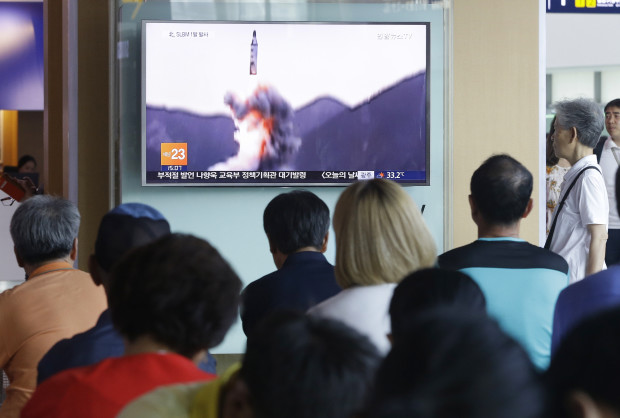North Korea’s missile test likely failed after sub launch

People watch a TV news program showing a file footage of North Korea’s ballistic missile that the North claimed to have launched from underwater, at Seoul Railway station in Seoul, South Korea, Saturday, July 9, 2016. North Korea on Saturday fired what appeared to be submarine-launched ballistic missile off its eastern coast, the U.S. and South Korea said, in the latest test that’s part of efforts by the North to advance technology capable of delivering nuclear warheads. AP
SEOUL, South Korea — North Korea launched a ballistic missile from a submarine but it likely failed in its early stage, the latest in a string of tests that are part of efforts by the North to advance technology capable of delivering nuclear warheads, the U.S. and South Korea said.
The U.S. Strategic Command said that the missile was tracked Saturday over the sea between the Korean Peninsula and Japan, where it apparently fell.
It was launched from a location near the North Korean coastal town of Sinpo, where analysts have previously detected efforts by the North to develop submarine-launched ballistic missile systems, said an official from Seoul’s Defense Ministry, speaking on condition of anonymity because of office rules.
South Korea’s Joint Chiefs of Staff said in a statement that it presumed the missile successfully ejected from the submarine’s launch tube, but failed in its early stage of flight. South Korea’s Yonhap news agency said that the missile likely flew only a few kilometers (miles) before exploding in midair, but the Defense Ministry official couldn’t confirm the report.
North Korea acquiring the ability to launch missiles from submarines would be an alarming development for rivals and neighbors because missiles from submerged vessels are harder to detect in advance. While security experts say it’s unlikely that North Korea possesses an operational submarine capable of firing missiles, they acknowledge that the North is making progress on such technology.
Article continues after this advertisementNorth Korea already has a considerable arsenal of land-based ballistic missiles and is believed to be advancing its efforts to miniaturize nuclear warheads mounted on missiles through nuclear and rocket tests.
Article continues after this advertisementU.S. Army Gen. Curtis M. Scaparrotti, NATO’s top military commander, told reporters Saturday that North Korea’s latest missile test represents a serious threat, both to the region and the U.S.
“With every launch, they’re getting better and they’re working out their problems,” said Scaparrotti, who until recently commanded U.S. forces in South Korea.
North Korea last test-fired a submarine-launched ballistic missile in April, calling it as a success that strengthened its ability to attack enemies with “dagger of destruction.” The North also test-fired a submarine-launched ballistic missile on Dec. 25, but that test was seen as a failure, the South’s Joint Chiefs of Staff said. The North first claimed a successful submarine-launched missile test in May last year.
Saturday’s launch came a day after U.S. and South Korean military officials said they were ready to deploy an advanced U.S. missile defense system in South Korea to cope with North Korean threats.
Seoul and Washington launched formal talks on deploying the Terminal High-Altitude Area Defense, or THAAD, after North Korea conducted a nuclear test and a long-range rocket launch earlier this year. China, Russia and North Korea all say the THAAD deployment could help U.S. radars spot missiles in their countries.
The deployment decision for THAAD was announced hours after North Korea angrily reacted to new U.S. sanctions on leader Kim Jong Un and other top officials for human rights abuses, with Pyongyang’s Foreign Ministry saying such measures were tantamount to declaring war.
North Korea has already been sanctioned heavily because of its nuclear weapons program. However, the action by the Obama administration on Wednesday marked the first time Kim has been personally targeted, and also the first time that any North Korean official has been blacklisted by the U.S. Treasury in connection with reports of rights abuses.
The United States stations about 28,500 troops in South Korea as deterrence against potential aggression from North Korea.